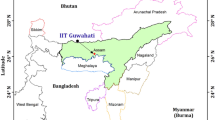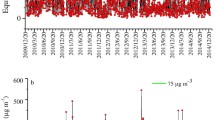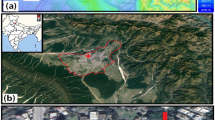Abstract
Black carbon (BC) aerosols are emitted into the atmosphere as a byproduct of different combustion processes and are reported to be a very strong absorber of solar radiation. In this paper, we present results on BC aerosols over Pune, a tropical urban city in south west India during Diwali festival in the month of November 2010. Daily mean BC showed about 5 % increase on Diwali day compared with preceding and succeeding period with concentrations reaching as high as about 21 μg/m3 in the morning on Diwali day, mainly due to the influence of extensive fireworks. However, the strong winds accompanied by occasional rainfall due to severe cyclonic storm “Jal” formed in the Bay of Bengal on the same day dampened this effect and reduced BC to about 2 μg/m3 within 6 h. There was only 5 % increase in mean BC concentration on Diwali day during 2010 as compared to the average increase of about 17 % during preceding 4 years on Diwali day, mainly due to the impact of weather conditions induced by Jal.








Similar content being viewed by others
References
Agarwal R, Jayaraman G, Anand S, Marimuthu P (2006) Assessing respiratory morbidity through pollution status and meteorological conditions for Delhi. Environ Monit Assess 114:489–504
Agrawal A, Upadhyay VK, Sachdeva K (2011) Study of aerosol behavior on the basis of morphological characteristics during festival events in India. Atmos Environ 45:3640–3644
Allen GA, Lawrence J, Koutrakis P (1999) Field validation of a semi-continuous method for aerosol black carbon (aethalometer) and temporal patterns of summertime hourly black carbon measurements in southwestern PA. Atmos Environ 33:817–823
Andronache C (2004) Estimates of sulfate aerosol wet scavenging coefficient for locations in the Eastern United States. Atmos Environ 38:795–804
Arnott WP, Hamasha K, Moosmller H, Sheridan PJ, Ogren JA (2005) Towards aerosol light absorption measurements with a 7-wavelength aethalometer: evaluation with a photo acoustic instrument and 3 wavelength nephelometer. Aerosol Sci Technol 39:17–29
Babich P, Davey M, Allen G, Koutrakis P (2000) Method comparisons for particulate nitrate, elemental carbon and PM2.5 mass in seven US cities. J Air Waste Manag As 50:11050–11095
Babu SS, Moorthy KK (2001) Anthropogenic impact on aerosol black carbon mass concentration at a tropical coastal station: a case study. Curr Sci 81(9):1208–1214
Babu SS, Moorthy KK (2002) Aerosol black carbon over a tropical coastal station in India. Geophys Res Lett 29(23):2098. doi:10.1029/2002GL015662
Bach W, Daniels A, Dickinson L, Hertlein F, Morrow J, Margolis S (1975) Fireworks pollution and health. Int J Environ Stud 7:183–192
Badarinath KVS, Kharol SK, Reddy RR, Gopal KR, Narasimhulu K, Reddy LSS, Kumar KR (2009) Black carbon aerosol mass concentration variation in urban and rural environments of India—a case study. Atmos Sci Lett 10(1):29–33
Barman SC, Singh R, Negi MPS, Bhargava SK (2008) Ambient air quality of Lucknow City (India) during use of fireworks on Diwali festival. Environ Monit Assess 137:495–504
Beegum SN, Moorthy KK, Babu SS, Satheesh SK, Vinoj V, Badarinath KVS, Safai PD, Devara PCS, Singh S, Vinod, Dumka UC, Pant P (2009) Spatial distribution of aerosol black carbon over India during pre-monsoon season. Atmos Environ 43:1071–1078
Chandrasekar R, Balaji C (2012) Sensitivity of tropical cyclone Jal simulations to physics parameterizations. J Earth Syst Sci 121(4):923–946
Crutzen PJ, Andreae MO (1990) Biomass burning in the tropics: impact on atmospheric chemistry and biochemical cycles. Science 250:1669–1678
Das N, Baral SS, Sahoo SK, Mohapatra RK, Ramulu TS, Das SN, Chaudhury GR (2009) Aerosol physical characteristics at Bhubaneswar, East coast of India. Atmos Res 93:897–901
Draxler RR, Rolph GD (2003) HYSPLIT (Hybrid single-particle Lagrangian integrated trajectory). NOAA Air Resources Laboratory, Silver Spring
Dumka UC, Moorthy KK, Kumar R, Hedge P, Ram Sagar Pant P, Singh N, Babu SS (2010) Characteristics of aerosol black carbon mass concentration over a high altitude location in the Central Himalayas from multi-year measurements. Atmos Res 96:510–521
Hansen ADA, Rosen H, Novakov T (1984) The aethalometer—an instrument for the real-time measurement of optical absorption by aerosol particles. Sci Total Environ 36:191–196
Heintzenberg J, Winkler P (1984) Elemental carbon in the urban aerosol: results of a seventeen months study in Hamburg, FRG. Sci Total Environ 36:27–38
Hirai K, Yamazaki Y, Okada K, Furuta S, Kubo K (2000) Acute eosinophilic pneumonia associated with smoke from fireworks. Int Med (Japan) 39:401–403
Jacobson MZ (2002) Control of fossil fuel particulate black carbon and organic matter, possibility the most effective method of slowing global warming. J Geophys Res 107(D19):4410
Kakoli K, Gupta AK (2007) Source apportionment of PM10 at residential and industrial sites of an urban region of Kolkata, India. Atmos Res 84:30–41
Kohler I, Dameris M, Ackermann I, Hass H (2001) Contribution of road traffic emissions to the atmospheric black carbon burden in the mid-1990s. J Geophys Res 106(D16):17997–18014
Liousse C, Cachier H, Jennings SG (1993) Optical and thermal measurements of black carbon aerosol content in different environments: variation of the specific attenuation cross-section, sigma(s). Atmos Environ Part A 27:1203–1211
Liu DY, Rutherford D, Kinsey M, Prather KA (1997) Real-time monitoring of pyrotechnically derived aerosol particles in the troposphere. Anal Chem 69:1808–1814
Mclain JH (1980) Pyrotechnics from the viewpoint of solid state chemistry. The Franklin Institute Press, Philadelphia, PA, pp 155–157
Pant P, Hedge P, Dumka UC, Sagar R, Satheesh SK, Moorthy KK, Saha A, Srivastava MK (2006) Aerosol characteristics at a high-altitude location in central Himalayas: optical properties and radiative forcing. J Geophys Res 111:D17206. doi:10.1029/2005JD006768
Park SS, Hansen ADA, Cho Sung Y (2010) Measurement of real time black carbon for investigating spot loading effects of aethalometer data. Atmos Environ 44(11):1449–1455
Raghavendra Kumar K, Narasimhulu K, Balakrishnaiah G, Reddy BSK, Rama Gopal K, Reddy RR, Satheesh SK, Moorthy KK, Babu SS (2011) Characterization of aerosol black carbon over a tropical semi-arid region of Anantapur, India. Atmos Res 100:12–27
Raju MP, Safai PD, Rao PSP, Devara PCS, Budhavant KB (2011) Seasonal characteristics of black carbon aerosols over a high altitude station in Southwest India. Atmos Res 100(1):103–110
Ram K, Sarin MM, Tripathi SN (2010) On-year record of carbonaceous aerosols from urban sites in the Indo-Gangetic Plain: characterization, sources, and temporal variability. J Geophys Res 115:D24313. doi:10.1029/2010JD014188
Ramachandran S, Rajesh TA (2007) Black carbon aerosol mass concentrations over Ahmadabad, an urban location in western India: comparison with urban sites in Asia, Europe, Canada, and the United States. J Geophys Res 112(D06211). doi:10.1029/2006JD007488
Ramanathan V, Crutzen PJ, Kiehl JT, Rosenfeld D (2001) Aerosols, climate and the hydrologic cycle. Science 294(5549):2119–2124
Ravindra K, Mor S, Kaushik CP (2003) Short-term variation in air quality associated with firework events: a case study. J Environ Monit 5:260–264
Reddy MS, Venkataraman C (1999) Direct radiative forcing from anthropogenic carbonaceous aerosols over India. Curr Sci 76:1005–1011
Safai PD, Kewat S, Praveen PS, Rao PSP, Momin GA, Ali K, Devara PCS (2007) Seasonal variation of black carbon aerosols over a tropical urban city of Pune, India. Atmos Environ 4:2699–2709
Safai PD, Kewat S, Pandithurai G, Praveen PS, Ali K, Tiwari S, Rao PSP, Budhawant KB, Saha SK, Devara PCS (2008) Aerosol characteristics during winter fog at Agra, North India. J Atmos Chem 61:101–118
Safai PD, Budhavant KB, Rao PSP, Ali K, Sinha A (2010) Source characterization for aerosol constituents and changing roles of calcium and ammonium aerosols in the neutralization of aerosol acidity at a semi-urban site in SW India. Atmos Res 98:78–88
Safai PD, Raju MP, Budhavant KB, Rao PSP, Devara PCS (2013) Long term studies on characteristics of black carbon aerosols over a tropical urban station Pune, India. Atmos Res 132–133:173–184
Singh RP, Dey S, Holben B (2003) Aerosol behavior in Kanpur during Diwali festival. Curr Sci 84:1302–1303
Srinivas CV, Yesubabu V, Hariprasad BRR, Ramakrishna SSV, Venkatraman B (2013) Real-time prediction of a severe cyclone ‘Jal’ over Bay of Bengal using a high-resolution mesoscale model WRF (ARW). Nat Hazards 65:331–357. doi:10.1007/s11069-012-0364-5
Stohl A, Wotawa G, Seibert P, Kromp-Kolb H (1995) Interpolation errors in wind fields as a function of spatial and temporal resolution and their impact on different types of kinematic trajectories. J Appl Meteorol 34:2149–2165
Tiwari S, Srivastava AK, Bisht DS, Bano T, Singh S, Behura S, Srivastava MK, Chate DM, Padmanabhamurty B (2009) Black carbon and chemical characteristics of PM10 and PM 2.5 at an urban site of North India. J Atmos Chem 62:193–209
Tiwari S, Chate DM, Pragya P, Ali K, Bisht DS (2012) Variations in mass of the PM10, PM2.5 and PM1 during the monsoon and the winter at New Delhi. Aerosol Air Qual Res 12:20–29
Virkkula A, Makela T, Hillamo R, Yli-Tuomi T, Hirsikko A, Hameri K, Koponen IK (2007) A simple procedure for correcting loading effects of Aethalometer. J Air Waste Manag As 57:1214–1222
Wang Y, Zhuang G, Xu C, An Z (2007) The air pollution caused by the burning of fireworks during the lantern festival in Beijing. Atmos Environ 41:417–431
Wehner B, Wiedensohler A, Heintzenberg J (2000) Submicrometer aerosol size distributions and mass concentration of the millennium fireworks 2000 in Leipzig, Germany. J Aerosol Sci 31(12):1489–1493
Weingartner E, Saathof H, Schnaiter M, Streit N, Bitnar B, Baltensperger U (2003) Absorption of light by soot particles: determination of the absorption coefficient by means of Aethalometers. J Aerosol Sci 34:1445–1463
World Health Organization Regional Office for Europe (2012) Report on Health Effects of Black Carbon by Janssen NAH et al, Denmark. ISBN: 978 92 890 0265 3
Acknowledgments
Authors are thankful to the Director, Indian Institute of Tropical Meteorology, Pune for encouragement to undertake this work. Authors are also thankful to the ISRO-GBP/ARFI, Department of Space, Government of India for providing financial support.
Author information
Authors and Affiliations
Corresponding author
Rights and permissions
About this article
Cite this article
Raju, M.P., Safai, P.D., Rao, P.S.P. et al. Impact of anthropogenic activity and cyclonic storm on black carbon during winter at a tropical urban city, Pune. Nat Hazards 71, 881–894 (2014). https://doi.org/10.1007/s11069-013-0937-y
Received:
Accepted:
Published:
Issue Date:
DOI: https://doi.org/10.1007/s11069-013-0937-y




